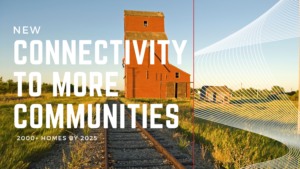Back in February, we talked about the concept of Technology Debt, which is, the longer you wait to implement new technology, the harder it is to do when the time comes.
Why?
Because the ‘cost of delay’ gap accelerates in a straight-line. Human resources become scarcer thus more expensive, the eventual disruption to your operation becomes more impactful and the opportunity cost of not introducing new technologies (which means better, faster, stronger, more efficient outcomes) sooner, is lost forever.
Unfortunately, the other side of Technology Debt is one that we see quite a bit, most commonly in underserved or legacy-served markets like
Saskatchewan has traditionally been (though not exclusively, as all Provinces have underserved pockets); organizations are forced to take on technology debt because they lack proper connectivity options in their area.
 Businesses (and consumers, for that matter) must now ask the following questions before choosing a location: Does my potential new site have proper Power, Water, Road Access? And, does it have adequate Network Connectivity?
Businesses (and consumers, for that matter) must now ask the following questions before choosing a location: Does my potential new site have proper Power, Water, Road Access? And, does it have adequate Network Connectivity?
You cannot operate a modern, fully optimized business (or household) in the 21st century without high quality network connectivity. At the recent National Rural Broadband Conference it was flatly stated that many remote workers (forced by Covid-19 to work from home) are now faced with a ‘Sophie’s Choice dilemma’ due to poor connectivity; either move or quit their jobs. Not a great situation during a very precarious employment cycle. As a highly industrialized nation, we want good people to work in their field of expertise, regardless of where they live.
What does ‘high-quality network connectivity’ mean?
- Fully guaranteed, stable, reliable bandwidth. In other words, dedicated connections, not ‘shared consumer-grade services passed off as business-grade’, that most incumbent Carriers offer.
- An SLA that offers 24/7/365 real-time local support, not ‘best-effort, next day/business hours-only’ support.
- Symmetrical connections that allow for full-duplex, bi-directional traffic enabling real-time applications like Zoom and Teams to work efficiently along with other cloud-based services.
- And, most importantly, all these features delivered over an end-to-end, business-grade fibre optic network, not a ‘fibre/copper/coax hybrid’ that limits the end-users’ capabilities by over-subscribing the network and throttling traffic during high-peak times of day.
Bottom line is this: it may not be your fault that you are running a technology debt. Your legacy Carrier may be forcing this situation on you. Do not tolerate this situation, its not acceptable and it is not necessary. Make sure that when it comes time to review your current network situation, demand the four things listed above. And if you find your current supplier can’t deliver on all of them, then contact sales@flexnetworks.ca, because FlexNetworks can.



